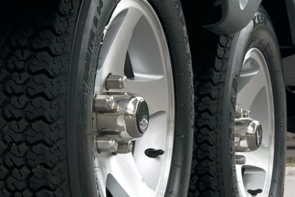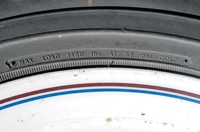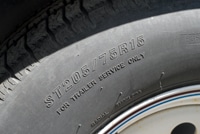See Related Story: RV Tire Basics
Your tires rate right up there as some of the most important hardware on your trailer. It’s incumbent on you to become somewhat of an expert on the subject. Your safety — as well as that of your loved ones and those you share the road with — depends on it.
A blowout on a single-axle trailer can cause a sudden shift in weight, creating an unstable load that could trigger a rollover. Even on a tandem- or triple-axle trailer, a tire failure can
prove to be a harrowing experience, and may cause collateral damage to the trailer.
Learning about trailer tires isn’t as intimidating or boring as you might think. Just basic knowledge is all that’s required to ensure safe, reliable operation from your trailer’s tires.
Trailer Tire Characteristics
The primary difference between passenger-vehicle tires and trailer tires is their intended use. In the tow-vehicle segment, the primary concerns are durability, low noise, ride comfort and wet traction, as well as good overall performance in varying road conditions. An automotive tire must do a variety of things well — but it is not frequently called upon to carry heavy loads for long periods of time. By contrast, the primary objectives of a trailer tire are load-carrying capacity, low rolling resistance, stability and long life.
As an example of tire differences, trailer tires (designated by the prefix ST, for Special
Trailer or Special Tire) are required to carry 10-percent more load than a comparably sized
P-metric (passenger car) tire. As such, trailer-tire construction may include different steel belts, plies and beads, as well as the use of thicker cords and larger diameter wire. Trailer tires also utilize a narrower tread width for reduced rolling resistance, and a shallower tread depth, which aids in tracking by reducing “tread squirm.” Trailer tires also contain rubber compounds that help them hold up to the elements better while in storage.
Years ago, trailer tires were mostly bias-ply, but today, travel trailers and fifth-wheels leave the factory with radial ST tires. The reasons are the same as for radial passenger car tires: Radial tires ride and handle better, have reduced rolling resistance and feature improved tread wear and braking-traction characteristics. In addition, radial trailer tires have a more rounded shoulder design, which allows them to perform better in lateral-scrub conditions, such as turning and backing.
So are ST tires your only choice? Not at all. It is possible, and practical, to use automotive light-truck (LT) radial tires on your trailer, provided you keep the load rating in mind. LT tires are also designed for heavy-duty use on pickups and such, and are fine alternatives to ST tires.
If you get a flat that destroys a tire such that it can’t be repaired, make sure that the replacement tire is of the same design (whether ST or LT, for example) and size as the original, and has a load rating that matches or exceeds the rating of your original tires.
Weight and Loading
Understanding your tire load rating is crucial to long tire life and safe travel. The pressure figure on the sidewall of an ST tire is the minimum pressure necessary to carry the maximum load. In other words, if a tire reads “Max load single: 3000 lbs at 65 psi cold,” 65 psi is the minimum cold-inflation pressure required to carry the maximum-load figure. Some RVers may be inclined then, to inflate the tire in our example to 65 psi — but unless that tire is carrying its maximum load, that inflation pressure may not be necessary. Tire manufacturers like Goodyear and Michelin publish load/inflation tables that indicate how much weight a tire can carry based on inflation pressure. Therefore, it is recommended that you weigh your trailer when it is loaded and ready for travel (including fuel, freshwater, supplies, etc.) to determine the amount of air necessary to carry your load. Weigh the trailer from side to side if possible (individual wheel weights are optimum) and inflate all tires to the pressure of the tire(s) carrying the heaviest load. Also, regardless of which side is heavier, make sure that tires on the same axle have the same inflation pressure.
All tires lose air, even if they are in perfect condition, so it’s
important to check your tire pressure regularly. Michelin recommends you do this every two weeks, or at least once each month and before embarking on any long trip. If your journey takes more than one day, tire pressure should be checked every morning; if you are on a day trip, do it before you leave, and again before returning home. Tire pressure should always be checked when the tires are cold, i.e., not driven for more than one mile.
Apart from the fact that correct inflation pressure will yield the best fuel economy, ride, tracking and longevity, it will also help prevent damage that can cause sudden tire failure. When an underinflated tire is run at normal highway speeds, the excessive sidewall and tread flex create heat that can damage the inner liner, casing and outer sidewall of the tire.
According to guidelines published by the Rubber Manufacturer’s Association (RMA), any tire
that has been run at less than 80 percent of recommended air pressure for the load it is
carrying should be inspected for possible damage.
If the weight of your trailer exceeds the tire’s load ratings, you are overloading the trailer with too much cargo, and exceeding the trailer’s gross vehicle weight rating (gvwr). Moving up to a higher load range tire (example: from a load range D to load range E) calls for a systematic approach to selecting the new hardware. Like tires, rims also have a pressure and load rating, and a tire with a higher load rating can exceed it, possibly resulting in catastrophic rim failure. A trailer’s gvwr is based on a number of factors, including tires, rims, axles and suspension; upgrading only one of these components almost guarantees the others will be over-stressed, and could fail prematurely. The moral is, examine your rims and upgrade them as needed when you bump up your tire-load-carrying capacity.
Buying a tire based on price alone is a big mistake. If the tires are too cheap to be true, compared to a good quality known brand, they aren’t worth buying. We had a tire sidewall blowout/shredding on a new lightweight name-brand test trailer at slow speed, in cool weather, properly inflated and lightly loaded. It turned out the off-brand tire could be purchased at $35 retail price, which meant it wholesaled around $20 or less. Few RVers would find $20 tires a good idea for safe, reliable family vacation travel. Choose a name brand with a good reputation and you’ll be that much ahead of the game.
What’s in a Number?
Besides load and inflation, another thing RVers must become accustomed with are the numbers molded into the sidewalls. What you need to concern yourself with in particular are size, load ratings and the DOT number that indicates (among other things) the date the tire was manufactured.
Let’s start with size. A typical ST tire would be an ST225/75R15; ST denotes “Special Tire” or “Special Trailer,” 225 is the cross-section width of the tire expressed in millimeters and 75 is the aspect ratio. The aspect ratio indicates the height or profile of the sidewall relative to the cross-section width. In this instance, the sidewall is 75 percent as tall as the cross section is wide. “R” indicates radial, and 15 is the rim diameter in inches.
Trailer tires have no speed rating. Unlike automotive tires, which may be H (130 mph) or V (149 mph), for example, trailer tires do not have to pass the same high-speed tests that passenger-car tires must. All ST tires are rated at 65 mph – so pulling a trailer faster than that, especially when you don’t know if your tires are properly inflated and/or loaded, is inviting disaster. In general it’s truly foolish to tow anything at excess speed and your tire’s speed rating is just one more reason to slow down and stay safe.
Finally, just because the tires on your RV have tread left doesn’t mean they
should not be replaced. Truck/RV tires are designed for long life, and you may only put 5,000 miles a year on your trailer. As such, it is likely that your tires will “time out” before they wear out. This is where those last four digits of the DOT number on the sidewall come in; the first two indicate the week the tire was made, the second two the year. So if the last four numbers read “4508,” as they do in the example below, it means that the tire was manufactured in the 45th week of 2008.
At the end of five or six years of service, you should have your tires closely inspected, regardless of the miles they have traveled. Moreover, many tire manufacturers are recognizing seven years as the age at which a tire should be replaced (including the spare), regardless of apparent condition.
Alignment and Balancing
If your trailer tires are exhibiting unusual wear patterns, improper alignment is the likely culprit. Trailers, like tow rigs, can suffer drastically from poor alignment. For example, a double- or triple-axle trailer can have one axle that is toed in (leading edge of the tires point toward each other) and another that is toed out. And, like a passenger car or truck, the camber (lean in or out at the top) and thrust angle (the direction the rear wheels are pointing in relation to the center-line of the vehicle) can be out as well. The results are poor tracking, increased drag and accelerated wear on the tires, not to mention reduced tow-vehicle fuel economy.
In some instances, the frame manufacturer may not have properly aligned the axle(s) with the frame, or the other axles, at the factory. Often it’s a case of damaged, overloaded, loose or worn components that allow the axles to fall out of alignment. Hit a big pothole or curb with the trailer and the axle can be bent, throwing the tire(s) out of alignment, just as a pothole strike can affect your tow vehicle.
Seek a qualified alignment shop that can check the components and re-align the axles to the hitch point. There are no alignment adjustments on a trailer axle so the shop will literally bend the axle as needed to re-aim the spindles, or as a drastic step, cut the spring mounts from the frame and reattach them in the proper places to ensure alignment.
Although trailer tires aren’t generally balanced at the factory, improperly balanced tires can also lead to unusual wear patterns. Imbalanced tires can “cup” and wear excessively at the heavy spot. If the imbalance is bad enough, you may be able to feel it, but the vibration could also be one or more out-of-round tires. An out-of-balance tire will shake worse the faster you go, while an out-of-round tire usually shakes at a certain speed, then may go away. A bad rim, improper tire mounting or a defective tire can cause an out-of-round condition. Visit a qualified tire center to balance the tires, and also check them for concentricity (roundness).
Maintenance
Properly inflated and correctly aligned trailer axles are the best way to maintain your
tires when towing. But what about when it’s stored? Here are a few suggestions:
- Inflate the tires to the recommended operating pressure, plus 25 percent (assuming the rim manufacturer’s inflation capacity is not exceeded, and that the trailer will be stored for a while).
- Be sure the storage surface is firm, clean, well-drained and reasonably level.
- Move the trailer at least every three months to prevent ozone cracking in the tire bulge area, as well as “flat spotting” from the prolonged strain of sidewall and tread deflection.
- Adjust tire-inflation pressure before putting the trailer back in service.
If one or both sides of the trailer are in direct sunlight during storage, tires should be covered. And if the trailer is stored indoors, be sure to keep it away from electric motors or other ozone-generating devices.
RVing is supposed to be about fun with friends and family. Don’t let a flat, or worse yet, a blowout, ruin your plans.
Goodyear Tire and Rubber Company, (330) 796-2121, www.goodyear.com.
Henderson’s Line Up Brake and RV Inc., (541) 479-2882, www.hendersonslineup.com.
Maxxis International, www.maxxis.com.
Michelin, (866) 866-6605, www.michelin-us.com.

